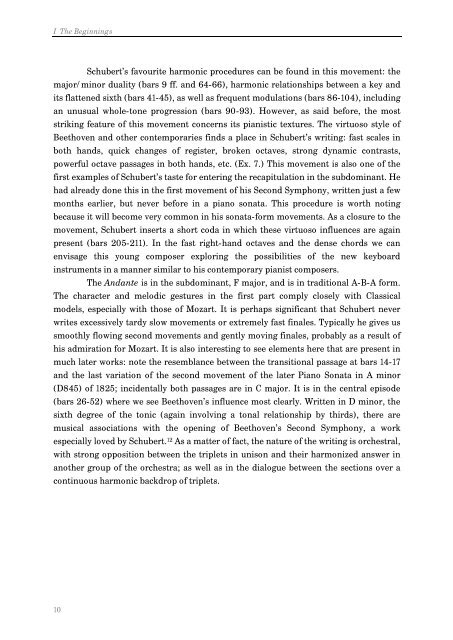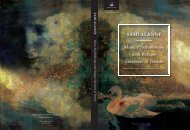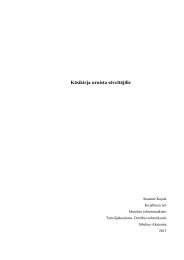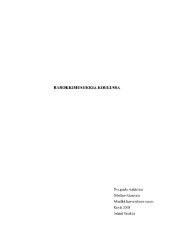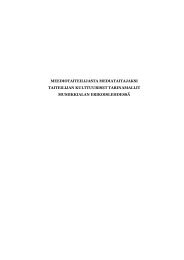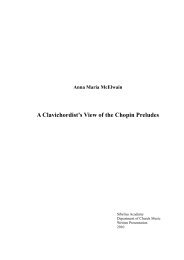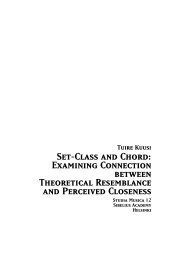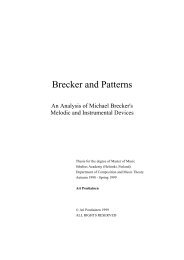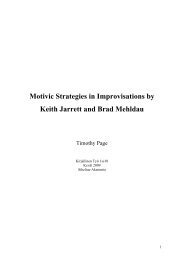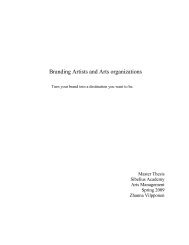The Unfinished Piano Sonatas of Franz Schubert Javier ... - Ethesis
The Unfinished Piano Sonatas of Franz Schubert Javier ... - Ethesis
The Unfinished Piano Sonatas of Franz Schubert Javier ... - Ethesis
You also want an ePaper? Increase the reach of your titles
YUMPU automatically turns print PDFs into web optimized ePapers that Google loves.
I <strong>The</strong> Beginnings<br />
10<br />
<strong>Schubert</strong>’s favourite harmonic procedures can be found in this movement: the<br />
major/minor duality (bars 9 ff. and 64-66), harmonic relationships between a key and<br />
its flattened sixth (bars 41-45), as well as frequent modulations (bars 86-104), including<br />
an unusual whole-tone progression (bars 90-93). However, as said before, the most<br />
striking feature <strong>of</strong> this movement concerns its pianistic textures. <strong>The</strong> virtuoso style <strong>of</strong><br />
Beethoven and other contemporaries finds a place in <strong>Schubert</strong>’s writing: fast scales in<br />
both hands, quick changes <strong>of</strong> register, broken octaves, strong dynamic contrasts,<br />
powerful octave passages in both hands, etc. (Ex. 7.) This movement is also one <strong>of</strong> the<br />
first examples <strong>of</strong> <strong>Schubert</strong>’s taste for entering the recapitulation in the subdominant. He<br />
had already done this in the first movement <strong>of</strong> his Second Symphony, written just a few<br />
months earlier, but never before in a piano sonata. This procedure is worth noting<br />
because it will become very common in his sonata-form movements. As a closure to the<br />
movement, <strong>Schubert</strong> inserts a short coda in which these virtuoso influences are again<br />
present (bars 205-211). In the fast right-hand octaves and the dense chords we can<br />
envisage this young composer exploring the possibilities <strong>of</strong> the new keyboard<br />
instruments in a manner similar to his contemporary pianist composers.<br />
<strong>The</strong> Andante is in the subdominant, F major, and is in traditional A-B-A form.<br />
<strong>The</strong> character and melodic gestures in the first part comply closely with Classical<br />
models, especially with those <strong>of</strong> Mozart. It is perhaps significant that <strong>Schubert</strong> never<br />
writes excessively tardy slow movements or extremely fast finales. Typically he gives us<br />
smoothly flowing second movements and gently moving finales, probably as a result <strong>of</strong><br />
his admiration for Mozart. It is also interesting to see elements here that are present in<br />
much later works: note the resemblance between the transitional passage at bars 14-17<br />
and the last variation <strong>of</strong> the second movement <strong>of</strong> the later <strong>Piano</strong> Sonata in A minor<br />
(D845) <strong>of</strong> 1825; incidentally both passages are in C major. It is in the central episode<br />
(bars 26-52) where we see Beethoven’s influence most clearly. Written in D minor, the<br />
sixth degree <strong>of</strong> the tonic (again involving a tonal relationship by thirds), there are<br />
musical associations with the opening <strong>of</strong> Beethoven’s Second Symphony, a work<br />
especially loved by <strong>Schubert</strong>. 12 As a matter <strong>of</strong> fact, the nature <strong>of</strong> the writing is orchestral,<br />
with strong opposition between the triplets in unison and their harmonized answer in<br />
another group <strong>of</strong> the orchestra; as well as in the dialogue between the sections over a<br />
continuous harmonic backdrop <strong>of</strong> triplets.


